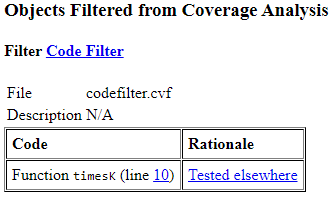slcoverage.CodeSelector Class
Namespace: slcoverage
Select custom C or C++ code for coverage filter
Description
Use objects of the slcoverage.CodeSelector class to specify custom
C or C++ code selection criteria for a filter rule.
The slcoverage.CodeSelector class is a handle class.
Creation
sel = slcoverage.CodeSelector(type,fileName) creates
CodeSelector object of the specified type based
on the specified fileName and sets the Type
and FileName properties.
sel = slcoverage.CodeSelector(type,fileName,functionName) creates
a CodeSelector object based on the specified C or C++
functionName in the file and sets the FunctionName property.
Filtering all functions that contain call points of
another function does not automatically filter the callee function. You must manually
add the callee function to the filter file.
sel = slcoverage.CodeSelector(type,fileName,functionName,expr,exprIndex)
creates a CodeSelector object for the specified expression and expression
index and sets the Expr
and ExprIndex properties.
sel = slcoverage.CodeSelector(type,fileName,functionName,expr,exprIndex,outcomeIndex)
creates a CodeSelector object based on the specified coverage outcome and
sets the OutcomeIndex property.
sel = slcoverage.CodeSelector(type,fileName,functionName,expr,exprIndex,outcomeIndex,parentExprIndex)
creates a CodeSelector object based on the specified coverage outcome
that belongs to an expression owned by parentExprIndex and sets the
DecOrCondIndex property
to parentExprIndex.


